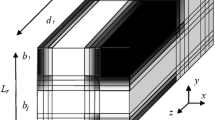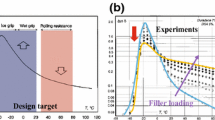Abstract
There is much current interest to incorporate nano-scale fillers into polymer matrices to achieve potentially unique properties. Compared with traditional microcomposites, a nanocomposite has a significant large ratio of interface area to volume that results in improved thermomechanical properties. Desired thermomechanical properties of polymer nanocomposites, to achieve the ever-increasing performance requirements, can be obtained by tailoring their microstructures. To this end, computational analyses of the relations between the thermomechanical properties, e.g., Young’s modulus, shear modulus, Poisson’s ratio, yield strength, coefficient of thermal expansion and coefficient of thermal conductivity, in different directions and the microstructures of polymer nanocomposites are performed. The asymptotic homogenization method based on the finite element analysis is used to model the thermomechanical behaviors of different polymer nanocomposites with periodic microstructures. The effects of adding silica, rubber, and clay nanoparticles to epoxy resin as a polymer matrix are analyzed. Mixtures of the nano-particles which differ in volume fraction, material type, size and/or geometry are considered. Some predictions of the thermomechanical properties are compared with experimental data in order to verify the applied modeling technique as an effective design tool to tailor optimal microstructures of polymer nanocomposites.
Similar content being viewed by others
References
Kwon S.C., Adachi T., Araki W., Yamaji A.: Effect of composing particles of two sizes on mechanical properties of spherical silica-particulate-reinforced epoxy composites. Compos. Part B 39, 740–746 (2008)
Asma Y., Isaac M.D.: Mechanical and thermal properties of graphite platelet/epoxy composites. Polymer 45, 8211–8219 (2004)
Uddin M.F., Sun C.T.: Strength of unidirectional glass/epoxy composite with silica nanoparticle-enhanced matrix. Compos. Sci. Technol. 68, 1637–1643 (2008)
Sanchez F., Ince C.: Microstructure and macroscopic properties of hybrid carbon nanofiber/silica fume cement composites. Compos. Sci. Technol. 69, 1310–1318 (2009)
Gusev A.A.: Numerical identification of the potential of whisker- and platelet-filled polymers. Macromolecules 34, 3081–3093 (2001)
Halpin J.C., Kardos J.L.: The halpin–tsai equations: a review. Polym. Eng. Sci. 16, 344–352 (1976)
Hashin Z., Shtrikman S.: A variational approach to the theory of the elastic behaviour of multiphase materials. J. Mech. Phys. Solids 11, 127–140 (1963)
Boutaleb S., Zaïri F., Mesbah A., Naït-Abdelaziz M., Gloaguen J.M., Boukharouba T., Lefebvre J.M.: Micromechanics-based modelling of stiffness and yield stress for silica/polymer nanocomposites. Int. J. Solids Struct. 46, 1716–1726 (2009)
Kalamkarov A.L., Georgiades A.V., Rokkam S.K., Veedu V.P., Ghasemi-Nejhad M.N.: Analytical and numerical techniques to predict carbon nanotubes properties. Int. J. Solids Struct. 43, 6832–6854 (2006)
Pierard O., Friebel C., Doghri I.: Mean-field homogenization of multi-phase thermo-elastic composites: A general framework and its validation. Compos. Sci.Technol. 64, 1587–1603 (2004)
Abdul Rashid E.S., Akil H.M., Ariffin K., Kooi C.C.: The flexural and morphological properties of α-alumina filled epoxy composites. Malays. Polym. J. 1, 25–38 (2006)
Sanada K., Tada Y., Shindo Y.: Thermal conductivity of polymer composites with close-packed structure of nano and micro fillers. Compos. Part A 40, 724–730 (2009)
Wang G.T., Liu H.Y., Saintier N., Mai Y-W.: Cyclic fatigue of polymer nanocomposites. Eng. Fail. Anal. 16, 2635–2645 (2009)
Mori T., Tanaka K.: Average stress in matrix and average elastic energy of materials with misfitting inclusions. Acta Metall. 21, 571–574 (1973)
Cho-Hsien, C.: Modeling of the Thermal Elasto-plastic Behavior for Composite Materials Using the Homogenization Method. PhD thesis, University of Michigan, USA (1992)
Takano N., Zako M., Kubo F., Kimura K.: Microstructure-based stress analysis and evaluation for porous ceramics by homogenization method with digital image-based modeling. Int. J. Solids Struct. 40, 1225–1242 (2003)
Shabana Y.M., Noda N.: Numerical evaluation of the thermomechanical effective properties of a functionally graded material using the homogenization method. Int. J. Solids Struct. 45, 3494–3506 (2008)
Yang Q.S., Becker W.: Effective stiffness and microscopic deformation of an orthotropic plate containing arbitrary holes. Comput. Struct. 82, 2301–2307 (2004)
Hassani B.: A direct method to derive the boundary conditions of the homogenization equation for symmetric cells. Commun. Numer. Methods Eng. 12, 185–196 (1996)
Takano N., Zako M.: Integrated design of graded microstructures of heterogeneous materials. Arch. Appl. Mech. 70, 585–596 (2000)
Ju J.W., Sun L.Z.: Effective elastoplastic behavior of metal matrix composites containing randomly located aligned spheroidal inhomogeneities, part I: micromechanics-based formulation. Int. J. Solids Struct. 38, 183–201 (2001)
Sun L.Z., Ju J.W.: Effective elastoplastic behavior of metal matrix composites containing randomly located aligned spheroidal inhomogeneities, part II: applications. Int. J. Solids Struct. 38, 203–225 (2001)
Schapery R.A.: Thermal expansion coefficients of composite materials based on energy principles. J. Compos. Mater. 2, 380–404 (1968)
Kerner, E.H.: The elastic and thermoelastic properties of composite media. In: Proceedings of the Physical Society: Section B69, pp. 808–813 (1956)
Shi, J.D., Pu, Z.J., Wu, K-H., Larkins, G.: Composite materials with adjustable thermal expansion for electronic applications. In: Proceedings of the Materials Research Society Symposium, pp. 229–234 (1997)
Goertzen W.K., Kessler M.R.: Thermal expansion of fumed silica/cyanate ester nanocomposites. J. Appl. Polym. Sci. 109, 647–653 (2008)
Chawla N., Chawla K.K.: Metal Matrix Composites. Springer, Berlin (2006)
Author information
Authors and Affiliations
Corresponding author
Rights and permissions
About this article
Cite this article
Shabana, Y.M., Wang, GT. Thermomechanical modeling of polymer nanocomposites by the asymptotic homogenization method. Acta Mech 224, 1213–1224 (2013). https://doi.org/10.1007/s00707-013-0868-4
Received:
Published:
Issue Date:
DOI: https://doi.org/10.1007/s00707-013-0868-4




